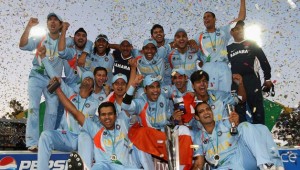India – a country of a billion, have never been light when it comes to the greats of the game, generation after generation, they’ve produced heavy weights but they’ve performed mainly in individual capacity. Very rarely we’ve seen a bunch of players, at the peak of their stardom, gelled together so well to comprehend each other’s game. But how did it happen? Surely a street smart brain, yet uncomplicated thought process of MS Dhoni isn’t enough to take them to the top.
Having watched India play from 1996/97 onwards, they were always a top heavy team who relied on their batsmen to score enough runs for their bowlers to defend. This was very true until recently. Indian ex-players, media anchor persons and cricket enthusiasts fail to recall any bowler (especially fast bowler) from 1990s, early 2000s who was a rare talent or is seen as legend, apart from Anil Kumble. How did they turn it around?
India has been known for its billionaire businessmen. Ambani, Mittal, Hinduja to name some big guns. Not to forget Jagmohan Dalmiya, a businessman himself, overhauled commercial operations of ICC to make World Cup tournaments profitable for ICC. When Jagmohan joined ICC as president, ICC only had a few thousand pounds in their kitty. After almost 4 years, a few hundred thousand pounds were turned into a multimillion pound money-making venture.
Nevertheless, the tide turned after World T20 win in 2007, in my opinion. Indian cricket board was quick to embrace T20 form of cricket, thanks to Indian Cricket League (ICL) – a rebellion cricket league formed on the model of Kerry Pecker’s World Series Cricket, which seemed to have run in opposition to established Indian cricket board – BCCI. With the help of strong corporate sector, long term planning, consistent policies based on merit at grass root level, BCCI was able to found a franchise based league known as Indian Premier League (IPL).
No one desires to lose their investments and whenever something is privatised, investor chooses to pick the best out of the rest. Players were initially selected from state teams playing in domestic tournaments such as Syed Mushtaq Ali Trophy, etc. Next few years saw franchises organising their own trials in different states to find talented players. This is the reason why we no longer see players like Badrinath who was consistent performer in Ranji Trophy and was able to play IPL on the basis of his domestic performance.
Young players from under 19 circuit were groomed by legends of the game, players like Stephen Fleming and Rahul Dravid, coaches/mentors like Steve Rixon to name a few. Young players who saw legends of the game on TV, all of sudden were sharing dressing rooms with them. In my opinion, this is the best thing that could have happened to Indian cricket because using their experience, they would have mentored young players in such a way that it would save them a lot struggle and fast track their careers. We need to remember, this was done at grass root level, not just in big cities but also at faraway places.
Once IPL took off, players’ remuneration reached the heights of Burj Khalifa, so did the expectations of and from players at domestic level. At one point, Indian domestic player would choose to sit at home and watch Ranji Trophy game, rather than playing it because an injury might jeopardise their chance of playing IPL. This is the mind-set which BCCI has changed in recent years by increasing players’ salaries for domestic players. A Ranji Trophy player can earn from INR 10,000 per day up to INR 40,000 per day. By far this is considerably higher than what a domestic player earns in neighbouring countries like Pakistan and Bangladesh. And the fact that Indian domestic season consists of six competitions and this does not include IPL and Karnataka Premier League, a domestic player can easily earn up to INR 10 lakhs in a season.
Players’ remuneration plays a big part but the fact that India has a very strong cricketing structure at state and association level which they’ve enjoy since British Raj. There are 58 cricket grounds which have hosted international cricket in India, so domestic players get the opportunity to play where their idols have played and I think it plays a huge part in developing a player.
Using TV as a medium of promoting and broadcasting domestic matches live, BCCI has created an environment which has harvested and nurtured a generation of quality cricketers at every level. India stands with only a few cricketing nations who can field two, even three competitive XI on the same day. They’ve invested heavily at under 19 and at A-Team level, by organising tournaments and tours at regular intervals, not to forget their Cricket Academies where 117 bowlers were reported with suspected actions in one and a half season. A staggering number but better than getting exposed at the highest level.
All in all, the knock on effect of IPL in the supply chain, which in turn resulted in heavy investment at domestic level, sound, viable commercial decision making, consistent policies and immaculate management has made India, a formidable force, one which is not bothered by domestic match fixing scandals. A solid domestic structure does not indigence a personality. Indian cricket does not need another Dhoni because they have the system to produce players who are smart enough and more importantly experienced enough to compete at the highest level.
